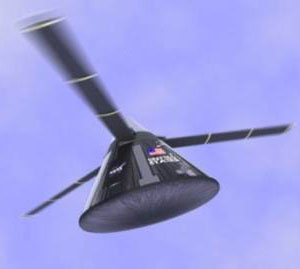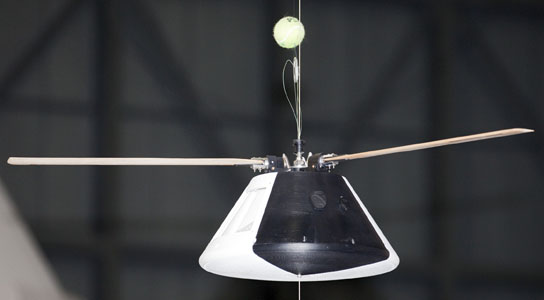NASA Testing Helicopter Rotor System for Capsule Reentry
October 29, 2012

An artist concept shows a capsule flying back to Earth with a rotor blade system instead of parachutes. The rotors deploy from the side of the capsule once the fall has slowed to subsonic speeds. Photo credit: NASA
A team of researchers took their scale models of space capsules to the Vehicle Assembly Building (VAB) at NASA’s Kennedy Space Center in Florida in order to test out a new rotor system that could be used instead of parachutes when capsules perform their re-entry into the atmosphere.
This design could give the capsule the stability and control of a helicopter, but it wouldn’t be powered. The wind passing over the rotors as the capsule descends would make the blades turn, which is known as auto-rotation and it has been proven repeatedly on helicopters, but has yet to be tried on spacecraft.
The purpose of this test is to study how the rotor starts to spin, states Jeff Hagen, an engineer at Johnson Space Center in Houston. The test was carried out at the VAB, from atop the 16th level. The two-pound model capsule was hung on a line, 480 feet above the concrete floor. The radio-control unit allowed the scientists to change the rotor’s pitch and slowed the fall four times as an unpowered craft.

A model capsule seen ahead of drop tests inside the Vehicle Assembly Building at NASA’s Kennedy Space Center in Florida to test a rotor system landing design. Photo credit: NASA/Kim Shiflett
This could give real spacecraft a soft landing, with enough control so that they could touch down anywhere in the world, instead of the ocean. The landings would also be targeted. This system would also fit in nicely with spent rocket boosters, since the rotors could be built into the booster frame and unfurled as the stage descends to the surface. This would be controllable and the landing would save the engines.
The development team had noted that some bombs have fins that flick open safely at high speeds. The returning spacecraft would use a similar mechanism to those fins. The biggest difference would be that the capsule’s blades would start spinning almost immediately.
This idea isn’t new since NASA researchers worked on a similar concept for the Apollo capsule, but engineers opted for a parachute return in order to shorten development time. Further testing would involve taking prototype capsules high into the air with balloons and dropping them, as well as trying out small capsules to return samples from the ISS.
No comments:
Post a Comment